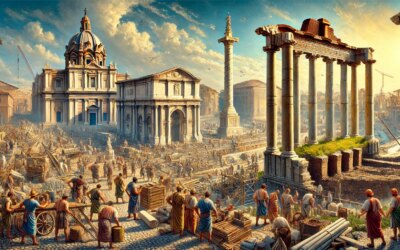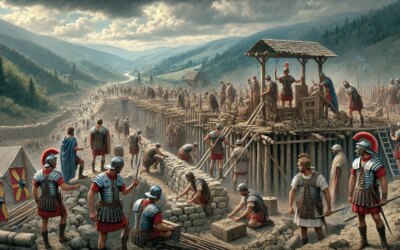Introduction: A Forum for the Ages
In the heart of ancient Rome, where political, commercial, and ceremonial life converged, a new forum rose in 112 AD. Commissioned by Emperor Trajan, the Forum of Trajan was the last and grandest of the imperial forums, a marvel of engineering and symbolism. Designed by the architect Apollodorus of Damascus, the complex celebrated Roman victory in Dacia and embodied the architectural and administrative peak of the Roman Empire.
Trajan: The Optimus Princeps
Marcus Ulpius Traianus, known to history as Trajan, ruled from 98 to 117 AD. A native of Hispania and a military man by training, Trajan expanded the empire to its greatest territorial extent. His conquests in Dacia (modern-day Romania) enriched Rome and funded massive building projects. Yet his legacy extends beyond conquest; it was his attention to infrastructure, justice, and public works that earned him the enduring title “Optimus Princeps”—the Best Ruler.
Why Build a New Forum?
By the early 2nd century AD, the older forums of Caesar and Augustus had become congested. Trajan envisioned a grand civic center that would reflect Rome’s glory and accommodate legal, commercial, and ceremonial needs. His new forum would also commemorate his triumph over the Dacians, projecting Roman might through monumental space and art.
The Design and Construction
The Forum of Trajan was an architectural tour de force. Excavation began after Trajan’s Dacian campaign, with entire sections of the Capitoline and Quirinal hills removed to create level ground. The complex included a grand entrance flanked by triumphal arches, a vast central piazza lined with porticoes and statues, the colossal Basilica Ulpia, two libraries (one Greek, one Latin), and the iconic Trajan’s Column—an enduring narrative frieze of his Dacian wars.
Basilica Ulpia: Heart of the Forum
The Basilica Ulpia was the largest basilica in Rome at the time, used for legal proceedings and public administration. It featured multiple aisles, towering marble columns, and a gilded roof. The space symbolized imperial justice and civic order, a secular temple to Roman governance and civic life. Its influence can still be seen in the basilica architecture of later Christian churches.
Trajan’s Column: History in Stone
Standing 35 meters high, Trajan’s Column is one of the most remarkable artistic achievements of the ancient world. Spiraling upwards with over 150 scenes and 2,500 figures, it recounts the Dacian campaigns with vivid detail and realism. Originally crowned with a statue of Trajan (later replaced with that of Saint Peter), the column doubled as his tomb, with his ashes interred in its base.
The Forum in Daily Life
Beyond its ceremonial purpose, the Forum of Trajan functioned as a bustling civic space. Merchants traded, orators spoke, judges deliberated, and citizens gathered beneath the marble colonnades. It stood as the physical manifestation of Rome’s imperial ideology: order, conquest, and civilization—crafted in stone and bronze.
Legacy and Influence
The Forum of Trajan set a new standard for urban planning and imperial expression. Its layout influenced civic architecture for centuries. Even as the Western Empire declined, the forum remained a site of significance. During the Middle Ages, much of it fell into ruin, but its fragments inspired Renaissance architects and fueled the imagination of modern historians.
Conclusion: A Monument to Rome and Its Maker
In 112 AD, as Trajan inaugurated his forum, Rome stood at its zenith—powerful, wealthy, and confident. The Forum of Trajan was more than a public space; it was an imperial statement carved into the city’s heart. Today, its ruins still speak of ambition, vision, and the enduring allure of a civilization that once ruled the known world. In stone and story, Trajan’s forum continues to echo the voice of empire.






